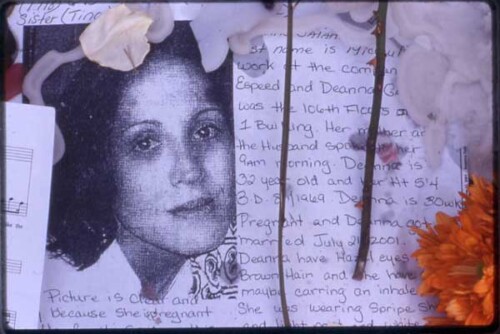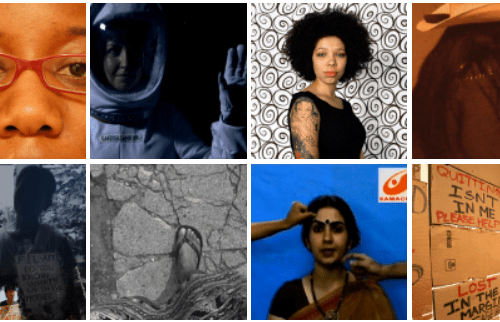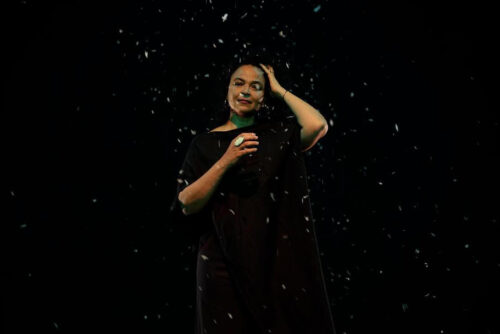Activist Grief1
I’d like to focus on what some of the interviews I conducted reveal about how activists grapple with the challenges of mourning, a process that continues to preoccupy them long after, and in some cases especially after, their involvement with a political movement. Overall, the interviews lend confirmation to Douglas Crimp’s warning that activism can suppress mourning, and they suggest that one of the aftermaths of activism for many people was the need to find a space for mourning that had not been available in the midst of activism. Indeed, one important value of oral history projects is that they can provide a public space for this emotional work at a time when the collectivity of activism may have faded and people are more isolated. My goal was to use the tools of oral history to create a public culture that would make visible the collective and shared dimensions of individual experiences that might otherwise seem idiosyncratic or abnormal or contrary to political action.
For example, Douglas Crimp’s comments about how militancy can prevent mourning are relevant to Marion Banzhaf’s account of how she responded to repeated experiences of loss. Banzhaf characterizes mourning as a protracted and belated process when talking about what happened once she left her work as director of the New Jersey Woman and AIDS Network (NJWAN):
Part of it was that when I left NJWAN in 1996, people were still dying right and left, and it was very difficult, all those deaths, and for a long time, as long as they keep coming, one right after the other, you can steel your defenses to keep up the fight. But it also makes the fight all the more immediate. You don’t have time to cry. You’ve got to keep on fighting. But now all those people are just gone. You just miss them. And so many women. So many women, not a few of whom, in my case, were actually lesbians. But lots of fabulous women. . . .
Then there’s the gay men, too, who were my friends, whom I miss. So when you’re out and removed from it your defenses are way less strong, so that I find now that it’s the deaths that remain with me, actually. I find this fascinating, actually. It’s one of the reasons why I’m not still doing AIDS work, I think. Because you have to do it fully. You can’t do just a little bit of AIDS work, because otherwise you’d be crying all the time, and you can’t be a very effective public speaker when you start crying in the middle of your rap. So I have found that to be true for myself, and that’s been a new discovery in the last couple of years, because I still do some training and it’s way harder than it used to be, in terms of really having to steel yourself. And I’m a person who had come to AIDS work having already experienced some multiple deaths in my life, my mother, very young, and my grandmother, who raised me, at age thirteen. So I already knew what death was about. I knew the impact, and my father died right when we were finishing Women, AIDS & Activism. When you’ve already experienced multiple losses, then you can deal with more multiple losses in a slightly different way. But then once you don’t have to anymore, then, great. Great. I’m outta here, in a way. So I think that’s happened to me. Not exactly consciously. In fact, I’m sort of articulating it for the first time in quite this way, now. I had had the other stuff, about the pharmaceutical critique. I understood that as a reason why I wasn’t doing AIDS work, but I hadn’t quite gotten this other, this mourning piece.
It’s telling that Banzhaf describes being less able to return to activism now that she has had some time to grieve. Mourning AIDS also brings in its wake other deaths and losses, such as, in her case, the deaths of her mother and grandmother. Being inside a crisis, particularly as an activist, does not always provide adequate opportunity for mourning. Moreover, because this unfinished mourning can prevent future activism, learning how AIDS activism has put people in contact with death and mourning is crucial to exploring activism’s legacies and its futures.
In understanding how mourning works in relation to activism, I have also been helped by David Eng and David Kazanjian’s rereading of Freud’s distinction between mourning and melancholy in their introduction to Loss; rather than read melancholy as a pathologized or incomplete version of mourning, Eng and Kazanjian suggest that the lack of closure and the holding on to the past that characterize melancholy can be a resource for cultural production. Such is the case with the persistent memory of those who have died in the ongoing lives of AIDS activists. Catherine Gund, for example, talks about her relationship with Ray Navarro as pivotal in her history with ACT UP, citing her involvement with DIVA-TV, ACT UP’s video collective, as part of a collaboration with him. She stopped going to ACT UP in 1990, the same year that Navarro died, although she also cites as a factor her disenchantment with the 1989 Stop the Church protest at St. Patrick’s Cathedral. Jean Carlomusto also mentions the impact of Ray Navarro’s death on the DIVA-TV collective, saying that although there were other reasons for the demise of its first incarnation, his death was a major factor. I sense that such stories of endings are always complicated. As we continue to talk about it, Gund suddenly realizes why she can’t remember much about that time; her long periods at the hospital with Navarro were both absorbing and mind numbing. This is a story of activism structured around the intensity of friendship – a friendship that combines romance and collective work. These are intimacies shot through with longing and loss, and they are the foundation of activism’s affective power. For Gund, it can be sad to recollect her ACT UP history and even its legacy because it involves taking the measure of years in which she has continued to live and her friend has not. She says:
To have a legacy is like a present. I think of Ray a lot as a reference for my ideas and experiences. I think about what he might have done in the same situation, where he might have gone with something, how he might have formulated a joke while walking down the street or watching a bad movie. And I do feel sad that he didn’t get to work with his ideas for too long, that he didn’t get to work them out. From what living the years since then has taught me, I can see that he was just getting started. I can appreciate the privilege of imagining what I want to make of my life and getting to try out some of those fantasies real. And there are times I wish it was him who was saying what he had done and not me imagining it.
Gund’s relationship with Navarro continues to be an active part of her life, even many years after his death. The above quotation emerged as the result of a conversation in which we edited the first version of her comments to remove a sense of survivor’s guilt that she felt no longer reflected her feelings.2 She notes that, in her ongoing fantasies about Ray, he is now the age he would have been if he had lived, rather than the age he was when he died, and she considers this a step forward in the mourning process. When I mentioned it to her, she liked the idea of a positive conception of melancholy, one that views an open-ended relationship with the dead as enabling rather than debilitating.
I was, of course, particularly eager to interview Jean Carlomusto herself about her ongoing experience of the ways memories of activism are combined with memories of death, and my expectations were not disappointed. In our interviews, she worried about ACT UP’s visual history being “used as wallpaper. Whenever you want to talk about activism, just throw in some protest footage, even if it’s not about the action you’re referring to.” She describes her struggle, in the period following her involvement with ACT UP, to live with the experience of mortality and how that has led to her renewed interest in history and archives:
That’s actually a very difficult thing to come by – recognizing the fleeting nature, the constantly changing nature of life. It almost sounds trite, but it’s an incredibly profound part, for me, of acclimating to life now. I had a very tough period of time where I almost didn’t go out for a year. A lot of different things played into that, but a lot of it was this struggle with mortality. Michael Callen wrote this song, “We Are Living in Wartime,” and the song is describing the experience that only people who survive, I guess, epidemics or natural disasters or wars are familiar with; where in such a short period of time you lose a whole part of your community of friends. All of a sudden people are gone from your life. . . .
I’m not advocating living like a hermit as a way of dealing with this. It’s just a phase I had gone through. But activism – in a way I think part of my way of dealing with this loss, related to activist work, was also somewhat activist in nature. Getting more involved with the Lesbian Herstory Archives. I really became interested in archives, the whole nature of that, and I think part of that is related to a more mature attitude toward history. I think there was a kind of mentality for those of us who were twenty-somethings during the AIDS activist movement, who believed there was nothing like this moment. This was truly mind-blowing what we were doing – and it was. But in the wake of the loss of that, I also began really culling or nurturing an appreciation for not just my history but just the historical artifact.
Carlomusto is one of many women I interviewed whose ongoing projects continue to engage with AIDS, and especially with death and loss. Just as video made possible a new kind of activist documentation, so too is it producing new ways of documenting activist memory. Carlomusto talks about the importance of having her archive, now easily accessible on a desktop computer, around her on a daily basis. She is working on a project in collaboration with Jane Rosett, called AIDS: A LIVING ARCHIVE™, which consists of a number of installation pieces designed to mobilize their combined archive of video and photographs to reflect on history and bring the past into the present. “I just feel like it’s vitally important to have access to these archives,” explains Carlomusto, “because when I go through them they constantly give me a new approach to the present.” For her, a readily accessible video archive “starts to break down the boundaries between space and time, so that past and present – well, at least the past – is just so accessible and able to be drawn into one’s work.”
Such is the case with “The Portrait Gallery”, which is part of AIDS: A LIVING ARCHIVE™ [and is featured in this issue], an altar-like installation that incorporates video portraits of AIDS activists, which are activated by an electronic button placed in front of a votive candle displaying the image of the activist. By incorporating video oral testimony into an installation that is charged with spiritual meaning, Carlomusto and Rosett acknowledge that reception of the archive is an emotional process, and they give viewers an opportunity to acknowledge those feelings within the context of the museum. Thus, they address the challenge of many trauma archives – how to present archival material in a way that doesn’t simply overwhelm or numb the observer. Their work suggests that it is not enough simply to accumulate archival materials; great care must be taken with how they are exhibited and displayed. The cultural knowledges embedded in forms such as documentary video and photography, performance, and installation art have much to offer as a resource for oral history archives. Not only is Carlomusto and Rosett’s video exhibited in a context that acknowledges its emotional power, but their insistence on the archive as living reconstitutes the work of mourning and memorial. At the heart of the archive, including the oral history archive, are practices of mourning, and the successful exhibition and distribution of the archive enables the work of mourning.




